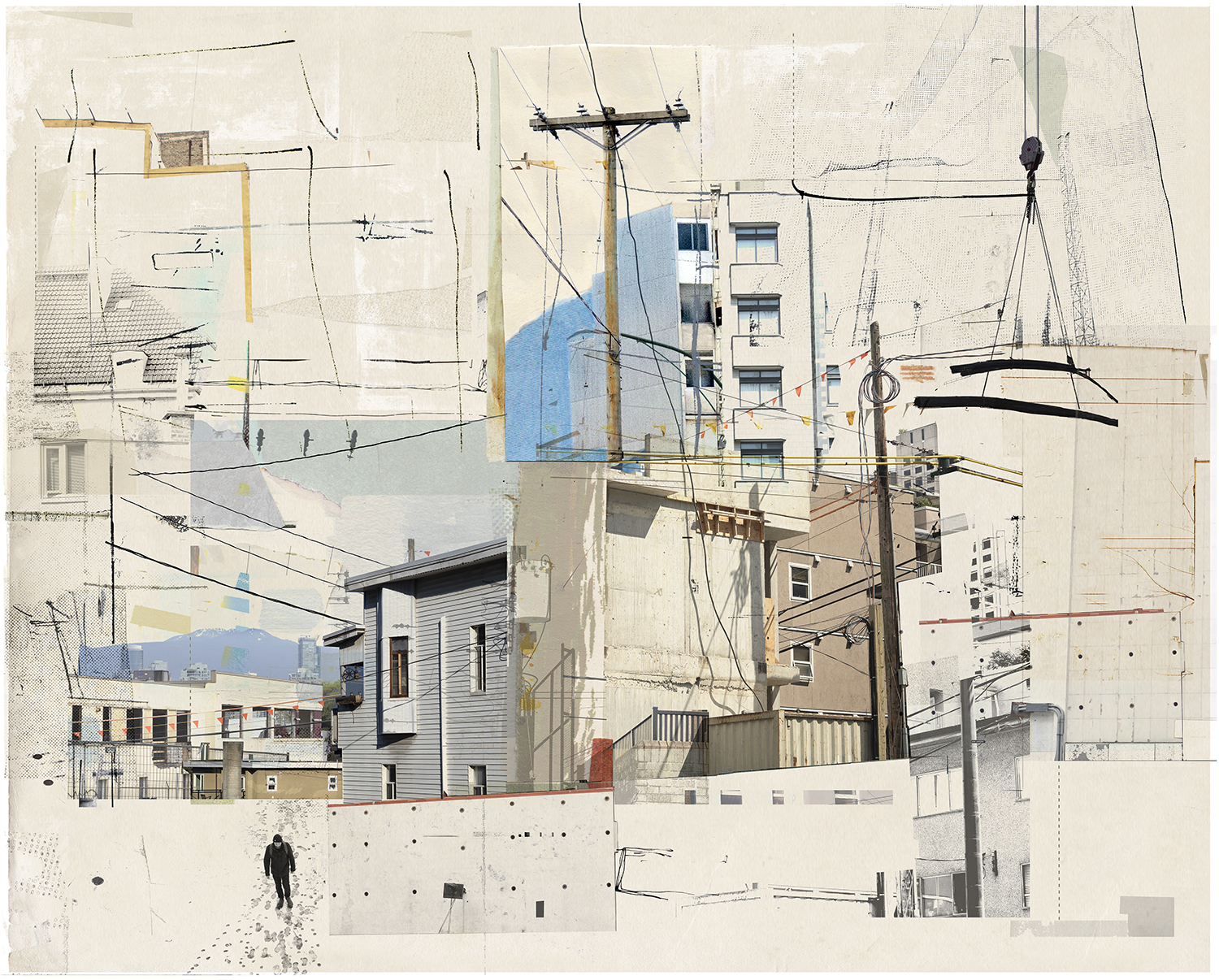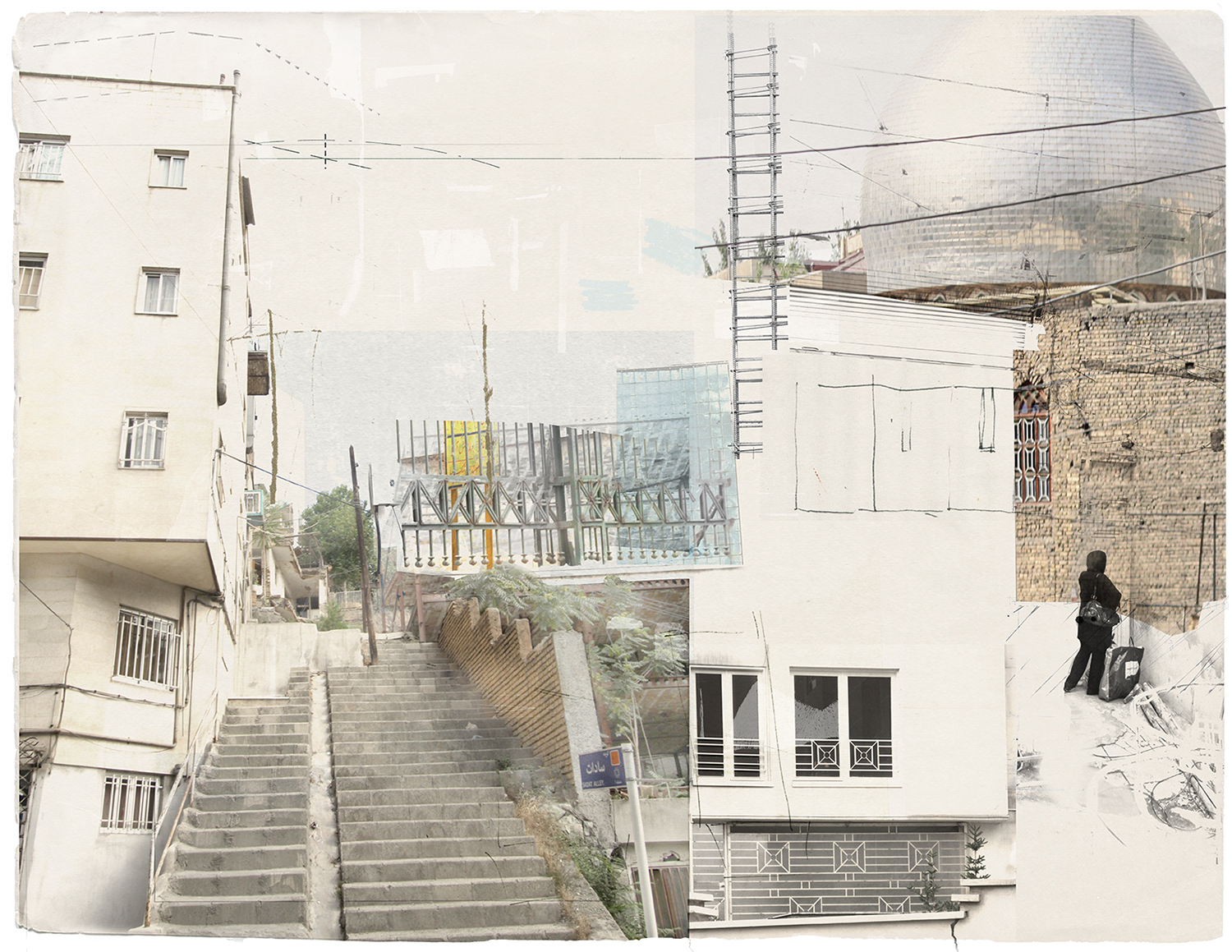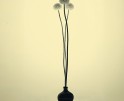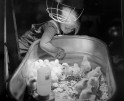Barbara Strigel: If We Were to Talk about Architecture
This week we are looking at the work of artists who submitted projects during our most recent call-for-entries. Today, Barbara Strigel and I discuss If We Were to Talk about Architecture.
Barbara Strigel is a photographer, collage artist and bookmaker living and working in Vancouver, British Columbia. She was born in Philadelphia and studied photography and printmaking at the School of the Museum of Fine Arts Boston. For over 20 years she taught photography, pottery and graphic design in a public high school in Seattle where she also advised the literary magazine and yearbook. Since her retirement in 2013, she has been establishing her fine art practice. Her collages, photographs and handmade books have been shown in both Canada and the United States and are held in collections at The Musuem of Fine Arts Houston, Otis College of Art and Baylor University as well as numerous corporate and private collections. She has been featured multiple times in the Blue Sky Gallery’s viewing drawers and the Art Rental Sales showroom at the Vancouver Art Gallery. In 2022, she had work featured in a 2 person show at FotoRelevance Gallery in Houston. Her work has been published in Diffusion Annual, PDN, Don’t Take Pictures, Photo Ed and Book Arts Du Livre and Contemporary Collage Magazine. In 2019, she was recognized in the Top 50 in Photo-Lucida’s Critical Mass. In 2020, she was awarded an honorable mention in Klompching Gallery’s annual Fresh competition. In 2022, she was recognized as a Finalist in LensCulture’s Fine Art Photography Awards.
Follow Barbara Strigel on Instagram: @barbarastrigel
If We Were to Talk about Architecture
In the shape of the city there are instances when architecture becomes an entry point. The shadow of leaves on a blue wall becomes a recollection of summer, telephone wires sing jazz and a repetition of square windows evoke a meditation. These fragmentary moments are resonant, sensory perceptions that invite connection to space.
I have been working with my street photographs to construct arrangements of architectural space. l digitally layer drawings and torn paper collage over fragments of the photographs, excavating and positioning to unify them into a state of visual grace. In the same way that an architect draws upon personal experiences and associations to design a building, I take a wall in Kanazawa, my memory of a watercolor by Paul Klee and a balcony where I once sat looking over the Ionian Sea and try to pull out some approximation of the resonance that prompted me to take a photograph.
Throughout this project, I have been inspired by the sketchbooks and diaries of the visionary Italian architect Aldo Rossi, who believed that architecture could express intangible longings and that it was fundamentally a search for meaning. I use photography and collage with a similar intention, to give form to the idea of resonant space.
Daniel George: Tell us how If We Were to Talk about Architecture began. What led to your interest in exploring the built environment in this manner?
Barbara Strigel: For the many years that I was a high school photography teacher, I lived in the suburbs and would drive around on the weekends photographing trees. I think I was looking for quiet. When I retired and moved to Canada, my life changed. I began to use photography and writing as a way to define my relationship to the city of Vancouver as well as cities I was travelling to. I was interested in the idea of a city being both a place of separation as well as connection and I was shooting street scenes of solitary figures moving through space. I thought that I might be able to convey the sense of possibility I found in urban life through the gestures of these figures, who walked purposefully forward, at ease in their own thoughts. Architecture was always part of what drew me toward certain corners and sometimes I shot studies of buildings that did not include a figure. I was reading about urban design and the idea that architecture could enhance people’s lives when I came across the autobiographical writing of Aldo Rossi, the visionary Italian architect. Rossi believed that architecture could express intangible longings and was fundamentally a search for meaning. In his writing, I recognized ideas that had been circling around in my work for years; about the city as a perception as well as a physical space and about the way we see architecture through the filter of our memories and experiences. He had done a series of drawings titled “Fragments”, juxtaposing pieces of architecture from multiple cities. These inspired me to experiment with fragments of my street photographs. I had years of travel photography to work with and when I pulled up these files, I felt I was conducting, in Rossi’s words, “a search which is also a recollection.”
DG: In both this project and others you have completed, you use collage to create a sense of harmony in a seemingly chaotic space. What draws you to this process, and how would you say it allows you to produce a sense of “visual grace?”
BS: Like street photography, collage is a response, an ordering and connecting of disparate elements to achieve the sense of a unified whole. Collage enables me to extract a fragment of a photograph and position it in a new context, one in which the resonance that prompted me to press the shutter is made clearer. I think of that alignment of form and feeling as visual grace-what Cartier Bresson called the decisive moment. In a larger sense, the fragmentary nature of collage mirrors the way cities are a compilation of impressions and recognitions.
DG: While a main focus of this work is the architecture itself, I find myself spending a considerable amount of time with the smaller figures within the frame. Those people navigating the spaces within. Could you talk a little about these smaller narrative vignettes?
BS: I like your use of the word navigating and what it suggests about moving through public space. Generally, I use figures to express a sense of containment or expansion. The size of the figures conveys my appreciation for scale and the grand surface of the city. Sometimes people assume that a solitary figure in an urban space represents alienation, but I believe cities can also be experienced as places where we live separately but together, in proximity to each other’s lives. The recognition of a stranger’s familiar gesture can be an affirmation.
DG: You write that with these images you are attempting to “pull out some approximation of the resonance that prompted [you] to take a photograph.” In what ways have you accomplished this? I am also interested in how you visually create what you describe as “fragmentary moments.” How do you feel this aesthetic invites “a connection to space?”
BS: I know that my experience of resonance in an architectural space begins with the associations I bring to it. I carry with me an abstract idea of city that I’ve formed from Edward Hopper’s paintings, Romare Bearden’s collages, Andre Kertesz’s photographs and Frank O’hara’s poems. I am drawn to buildings that remind me of my childhood in Pennsylvania. If I can extract through photography the particular elements of architectural space that hold these associations, perhaps my work can approximate a more expansive view. I think it’s important to be appreciative of the surface of space and I’ll quote Robert Adams, “.. the surface is where we have to live most of the time. Alternatively, if some art can allow us briefly to escape that surface so that we can recover a memory or an intuition of what is affirmable, that contributes too.” (Why People Photograph)
Posts on Lenscratch may not be reproduced without the permission of the Lenscratch staff and the photographer.
Recommended
-
Scott Offen: GraceDecember 12th, 2025
-
Izabella Demavlys: Without A Face | Richards Family PrizeDecember 11th, 2025
-
2025 What I’m Thankful For Exhibition: Part 2November 27th, 2025
-
2025 What I’m Thankful For Exhibition: Part 3November 27th, 2025
-
2025 What I’m Thankful For Exhibition: Part 4November 27th, 2025




























































